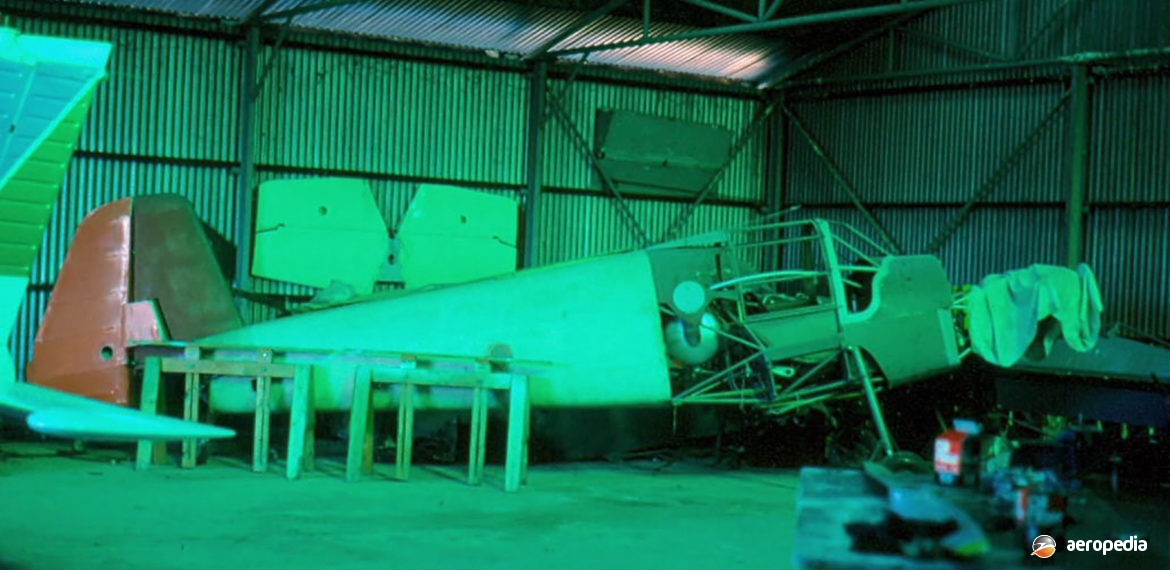Photograph:
Bucker Bu 181 Bestmann under restoration at Gunnedah, NSW (David C Eyre)
Country of origin:
Germany
Description:
Light military training monoplane
Power Plant:
One 78 kw (105 hp) Hirth HM 504 four-cylinder in-line inverted air-cooled engine
Specifications:
Length: 7.75 m (25 ft 5 in)
Height: 2.1 m (6 ft 5 in)
Wing area: 13.5 m² (145.3 sq ft)
Max speed: 215 km/h (133 mph)
Cruising speed: 195 km/h (121 mph)
Landing speed: 70 km/h (43 mph)
Climb to 1,000 m (3,280 ft): 5.3 mins
Climb to 3,000 m (9,842 ft): 20.8 mins
Service ceiling: 5,000 m (16,400 ft)
Range: 800 km (497 miles)
Empty weight: 480 kg (1,056 lb)
Loaded weight: 750 kg (1,650 lb)
History:
The Bucker Bu 181 Bestmann series was designed as a sport and touring aircraft, the prototype flying for the first time in February 1939. In the event, the imminence of war led to the type being adopted by the German Luftwaffe as a primary trainer, and it was built in large numbers.
In addition to German production at Rangsdorf near Berlin, where some 5,900 were built, 708 were built by Fokker at its plant in Amsterdam in the Netherlands during World War II, these being Bu 181As and Bu 181Ds, the latter having minor internal changes. Some 342 were delivered by Fokker in 1943, and a further 335 in 1944.
As well, 125 were built by A B Hagglund & Soner in Sweden as the Sk 25 for the Swedish Air Force.
Preparations for manufacture in Czechoslovakia at the Zlin factory in 1944 were in place but the German forces had to withdraw, leaving the jigs and tooling in situ. After liberation it was built at Otrokovice as the Zlin 281 and 381 for civil use with the 78 kw (105 hp) Toma 4 engine and the Walter Minor 4-III engine respectively; and for the Czech Air Force, with which it was known as the C.6, being fitted with the Walter Minor 4-III engine.
Eventually in the 1950s it was built, in much modified form, as the Gomhouri in Egypt by the Heliopolis Aircraft Works under Czech licence. The initial production model for the Egyptian Air Force was essentially the Z.381 with the 78 kw (105 hp) Walter Minor 4-III engine. It was developed to the Mk 2, which had a 108 kw (145 hp) Continental C-145 engine, and was supplied to civil flying schools and to the air forces of Jordan, Libya, Saudi Arabia, Somalia and the Sudan.
Further models appeared, including the Mk 3, which differed solely in having double disc-brakes and a castoring tailwheel; the Mk 4 being similar but with reduced fuel capacity; the Mk 5 reverting to the Walter Minor 4-III engine; and the Mk 6 having the 108 kw (145 hp) Continental O-300 engine.
Considered ideal as an advanced trainer by the German Luftwaffe, the Bestmann had bucket seats designed for a seat-type parachute. The fuselage was of steel tube with detachable metal panels back to the trailing-edge of the wing, the rear fuselage being wooden monocoque. The wing was of basic wooden construction with plywood and fabric covering.
During World War II the type was used extensively as a communications aircraft and, like the Messerschmitt 108, was used as a glider tug.
In 1990 an English aviation enthusiast who moved to Australia had his Swedish built Sk 25 Bestmann (Model Bu 181B-1 – G-AHNH – c/n FU25083) shipped to Australia and, after some work was carried out on its restoration in Sydney, NSW it was moved to Gunnedah, NSW where restoration continued. However, by 2016 it was not located at Gunnedah airport and its whereabouts was not known. The owner, Mr Anderson, moved to a property near Oakey QLD, with the Percival Proctor NP184. In 2020 he moved to Gawler, SA, with the Proctor and the Bestmann. The Proctor was gifted to the South Australian Aviation Museum. The Bestmann remains under restoration at Gawler.
In the late 1990s a further two examples of the Bestmann series were imported to Western Australia where they were placed in storage, probably in the Serpentine area. Another Bestmann (c/n 2) was imported to Australia in February 1994 and was placed in storage. A Heliopolis BU-81 (an Egyptian-built Bestmann) has been was restored, becoming VH-BEZ (c/n 67 – ex EAF15-8. C-CGEV) and flew at the Latrobe Valley VIC on 19 February 2021 to Raptor Aviation Pty Ltd of Brighton VIC. It had been imported from the United Kingdom in 2000 and was flown in 2014 with a Walter Minor engine which reolaced a Continental O-300 which was installed when it arrived.
Also in the late 1990s an American company, KNR Aircraft Co Inc of St Louis Park, Minnesota, commenced production of a kitplane of the Bu 181D Bestmann Mk 6 for homebuilt construction and, fitted with a 108 kw (145 hp) Continental O-300A engine, a number have been built or are being built around the world.

